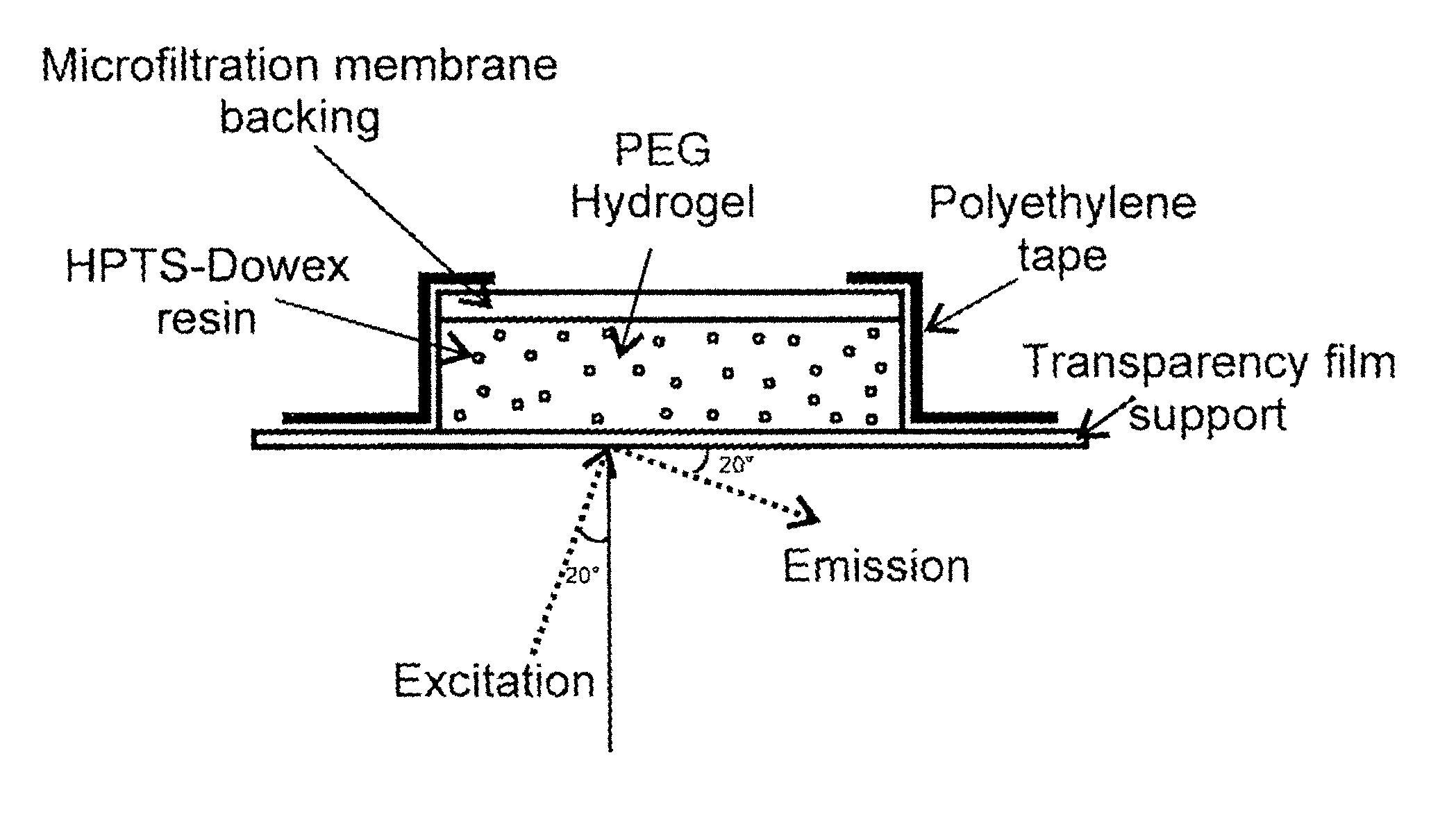Ratiometric fluorescent pH sensor for non-invasive monitoring
a ratiometric and fluorescent technology, applied in the field of ratiometric fluorescence measurement techniques, can solve the problems of limiting the useful lifetime of the sensor, additional calibration parameters or operations, and difficult measurement in highly scattering or fluorescent media
- Summary
- Abstract
- Description
- Claims
- Application Information
AI Technical Summary
Benefits of technology
Problems solved by technology
Method used
Image
Examples
example 1
Materials
[0063]The fluorescent dye 8-hydroxy-1,3,6-pyrene trisulphonic acid trisodium salt (HPTS) was obtained from Molecular Probes Inc. (Eugene, Oreg.). 6,8-dihydroxy-1,3-pyrenedisulfonic acid disodium salt (DHDS) was urchased from Fluka (Milwaukee, Wis.). Methacrylic anhydride (94% purity), anhydrous dimethyl formamide (DMFP, otassium carbonate and phenolsulfonephthalein sodium salt (Phenol Red) were purchased from Sigma-Aldrich Inc. (St. Louis, Mo.). Poly(ethylene glycol) diacrylate with an average molecular weight of 4000 was obtained from Polysciences Inc. (Warrington, Pa.). The photoinitiator Darocur® 1173, was supplied by Ciba Specialty Chemicals (Tarrytown, N.Y.).
[0064]Dowex 1×8-400 strongly basic anion exchange resin was obtained from Sigma Chemical Co. (St. Louis, Mo.). White microfiltration membranes in mixed esters of cellulose with a nominal pore diameter of 0.2 μm (Kimble) were used to optically isolate the sensor and as a support backing. The monomer 2-hydroxyethyl m...
example 2
[0066]The overnight seed culture consisted of a 1% inoculum of Escherichia coli JM105 strain frozen stock in 20 mL LB nutrient broth, incubated at 37° C. with shaking at 260 rpm (Orbit Environ Shaker, Lab-line Instruments, Melrose Park, Ill.). The fermentation was carried out at room temperature in a 500 mL shake flask containing 100 mL of LB broth that was inoculated with 2.5% seed culture. The shake flask was placed on a rotating shaker (LaPine Scientific Co., Berkeley, Calif.) set at 100 rpm. Dissolved oxygen and pH were not controlled.
example 3
Synthesis of 6-methacryloyl-8-hydroxy-1,3-pyrenedisulfonic acid (MA-HPDS)
[0067]The indicator DHDS (100 mg) was dissolved in DMF (10 mL) in a 25 mL reaction vessel. Potassium carbonate (1 g) and methacrylic anhydride (1:1 eq., 36 μl L) were added. The vessel was stoppered and placed in a 70° C. water bath to react for 12 hours. The cooled reaction mixture was filtered. The solvent was removed from the filtrate in a rotary evaporator to yield the crude solid product (MA-HPDS).
[0068]Presumably, this product contains a mixture of the modified dye MA-HPDS with an unknown amount of reaction by-products that include unmodified DHDS and methacrylic acid salts. Further purification is unnecessary prior to copolymerization of the modified dye MA-HPDS and poly(ethylene glycol) diacrylate (PEG-DA). The reaction scheme is depicted in FIG. 1A.
PUM
| Property | Measurement | Unit |
|---|---|---|
| pH | aaaaa | aaaaa |
| pka | aaaaa | aaaaa |
| excitation wavelengths | aaaaa | aaaaa |
Abstract
Description
Claims
Application Information
 Login to View More
Login to View More - R&D
- Intellectual Property
- Life Sciences
- Materials
- Tech Scout
- Unparalleled Data Quality
- Higher Quality Content
- 60% Fewer Hallucinations
Browse by: Latest US Patents, China's latest patents, Technical Efficacy Thesaurus, Application Domain, Technology Topic, Popular Technical Reports.
© 2025 PatSnap. All rights reserved.Legal|Privacy policy|Modern Slavery Act Transparency Statement|Sitemap|About US| Contact US: help@patsnap.com



